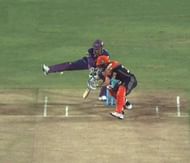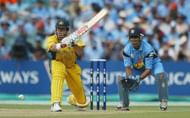Whenever anyone talks about Cricket, batting, bowling and fielding are the areas that are discussed. Wicket-keeping is seldom discussed. But like everything else in the game, wicket-keeping also requires a certain level of skill. It is an art in itself.
Earlier, it was believed that like bowlers and batsmen, wicketkeepers too were born and you could not just tell any person to don the big gloves because he would not be able to the job as well as a regular keeper would.
A non-regular or a makeshift wicket-keeper would not have the anticipation about how high and where the ball is going to come from the fielder or the bowler. He would not have the instinct about when to take the gloves off. Let’s face it, a makeshift wicket-keeper will always be slower than a regular wicket-keeper.
But as shorter formats of Cricket were devised and ODIs and Twenty20s became the ‘in’ thing, teams- international and domestic, chose to forget this notion when it came to selecting a wicket-keeper in the squad for any series. They looked for good batsmen who could be made wicket-keepers, instead of looking for wicket-keepers who could bat.
This tactic has been used by teams in the IPL for quite a while now.
Over the last five to six editions of the IPL, the trend of fielding makeshift wicket-keepers has been on the rise. Robin Uthappa kept wickets for the now defunct Pune Warriors India from 2011-13 and continues to do so for Kolkata Knight Riders.
Mumbai Indians used Ambati Rayudu as their gloveman in the 2014 and 2015 seasons.
In IPL 2016, Royal Challengers Bangalore used Kedar Jadhav and KL Rahul as wicket-keepers. They have also used AB de Villiers as a wicket-keeper. Sanju Samson had donned the big gloves for Rajasthan Royals and this season, Delhi had fielded four wicket-keepers in a few of their matches, out of which at least two- Samson and Rishabh Pant were not regular ‘keepers.
International cricket too has seen teams fielding stand-in wicket-keepers.
Rahul Dravid, one of India’s best batsmen and an excellent slip fielder, has kept wickets for the national side. Even though he was not exactly ‘the wall’ while behind the stumps, Dravid more than made up for it with his batting skills.
Since Kumar Sangakkara’s retirement, Dinesh Chandimal has donned the big gloves for Sri Lanka in Tests and ODIs. They had also tried Tillakaratne Dilshan for that role but did not persist with him.
England too have tried Jonny Bairstow and he has now become their preference for tests after the retirement of Matt Prior.
South Africa made de Villiers in charge of keeping wickets post the retirement of Mark Boucher in 2012 until Quinton de Kock cemented his place in the national side.
Pros and cons of preferring non-regular wicket-keepers
This idea of preferring batting skills over wicket-keeping skills when selecting wicket-keepers has its own merits and demerits.
The benefit of this idea is that if the wicket-keeper is also a good batsman, then it allows that extra bowler or batsman or all-rounder to be included in the squad to strengthen the side as a whole. It makes the side more stable.
Though this idea may work in limited overs cricket, but it will not work in Test cricket.
A person who is not used to standing behind the stumps for long periods of time cannot be expected to keep wickets for an entire day of test cricket without lapses in concentration. Another shortcoming is the fact that there may be errors behind the wickets that may end up being costly for the fielding side.
In the Test series between England and Sri Lanka, Jonny Bairstow dropped Dimuth Karunaratne off the bowling off Chris Woakes at Lord’s. It was a straightforward chance which was grassed when the Sri Lankan was on 28 and went on to add 23 more runs.
Though this dropped catch did not hurt England much, it highlights the importance of regular wicket-keepers in test cricket. It shows the amount of concentration required in the longest format and that keeping wickets in tests is not everyone’s cup of tea.
Importance of regular wicket-keepers and a comparison
Some people might argue that a stand-in wicket-keeper is just as efficient as a regular one. That he can collect the ball behind the stumps as well as a regular ‘keeper.
A makeshift wicket-keeper may be as good as a regular one when he is standing back. He might be able to dive around and save the ball from reaching the fence or take spectacular catches from, say 15-16 yards behind the stumps. This can be attributed to the improvement in fielding standards in general. With an improvement in infrastructure globally, players are encouraged to throw themselves around on the field and their reflexes also improve.
Standing up to the stumps is a different ballgame, though.
This is where a regular wicket-keeper’s need may be felt more. This is where a non-regular wicket-keeper is more likely to be found wanting. Catching a ball coming off the edge of the bat or collecting a ball sent down the leg side requires quick movement and most of all, skill. The anticipation can be developed if it is there, but might be difficult to produce from nothing.
In the 2016 edition of the IPL for example, regular glovemen like Naman Ojha and Wriddhiman Saha were comfortable behind the stumps, while KL Rahul, a non-regular gloveman, had a tough time standing up to the stumps. There were many instances when he was unable to collect the ball cleanly when he was keeping to medium pace bowlers like Stuart Binny. At times he was unable to pick Yuzvendra Chahal’s spin.
This came back to haunt Royal Challengers Bangalore when they were hosts to Kolkata Knight Riders. The home side were on course for a win when Rahul dropped a catch and missed a stumping opportunity off Chahal. The surviving batsman on both occasions was Andre Russell. Those errors behind the stumps proved to be costly as the visitors went on to win the match, thanks to Russell and Yusuf Pathan, from a hopeless position.
----
Cricket is a game which is slowly becoming a game of perfectionists. Due to ODIs and T20s, proper batsmen, bowlers, and all-rounders are in demand. To see regular wicket-keepers being left out for non-regular ones is disheartening and a bit ironic.
Genuine wicket-keepers are indeed an endangered species and it will be a pity if they become extinct. There is a need to recognize the importance of wicket-keepers in cricket. They should be born and not made. Genuine 'keepers should be encouraged so that they improve on their faults, correct them so that they can leave their mark as both glove-men and batsmen on the cricket world.
Get real-time updates on IPL 2025, live scores, IPL Prediction, match schedule, points table,Result & squad -CSK, MI, RCB, KKR, SRH, LSG, DC, GT, PBKS



